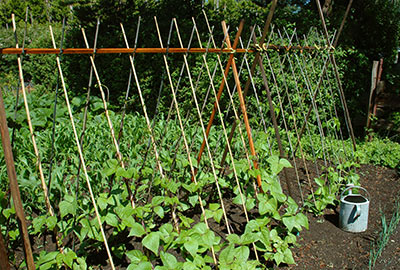Six Common Problems and Non-Problems With Pole Bean

Gardeners growing pole beans see a range of issues: some are problems, some are not. Here is a quick overview.
Problems With Pole Beans
Blossom drop: Bean plants will drop blossoms due to low humidity, excessive smog or air pollution, dry soil or uneven water, wind, excessive soil nitrogen, daily or consistent high temperatures above 85°F, heat waves above 90°F, and cold and/or wet weather.
Flowering without setting pods: This may be caused by poor pollination/lack of pollinators, zinc deficiency, dry soil, inconsistent watering, excessive soil nitrogen, or high temperatures.
Low yield: Overly wet soil, dry soil, or infertile soil may result in slow-growing or stunted plants and low yields. Bean plants produce fewer or no new pods while maturing existing pods; harvests of snap beans may be greatly reduced if if bean pods are allowed to mature.
Deformed pods: May be the result of lack of moisture, poor soil fertility, or insect damage during blooming.
Tough or fibrous bean pod: This occurs naturally as pods mature and most commonly is the result of pods being left unharvested on the plant for too long. It may also be caused by warm or hot temperatures during pod set.
Not a Problem
Are your pole-bean vines so vigorous that you’re running out of real estate on your trellis, support, or stake? Many pole-bean varieties grow vigorously to 10 feet in length. If your beans are growing past the trellis height, you can loop them over and encourage them to work their way back down a sunny area along their trellis or support.
For complete growing instructions for pole bean for your specific area, go to GardenZeus and enter your zip code, then go to pole bean.
Other articles of interest:
5 Tips for Harvesting Pole Beans
Pole Beans: Tips to Maximize Your Harvest
5 Tips for Using and Storing Pole Beans